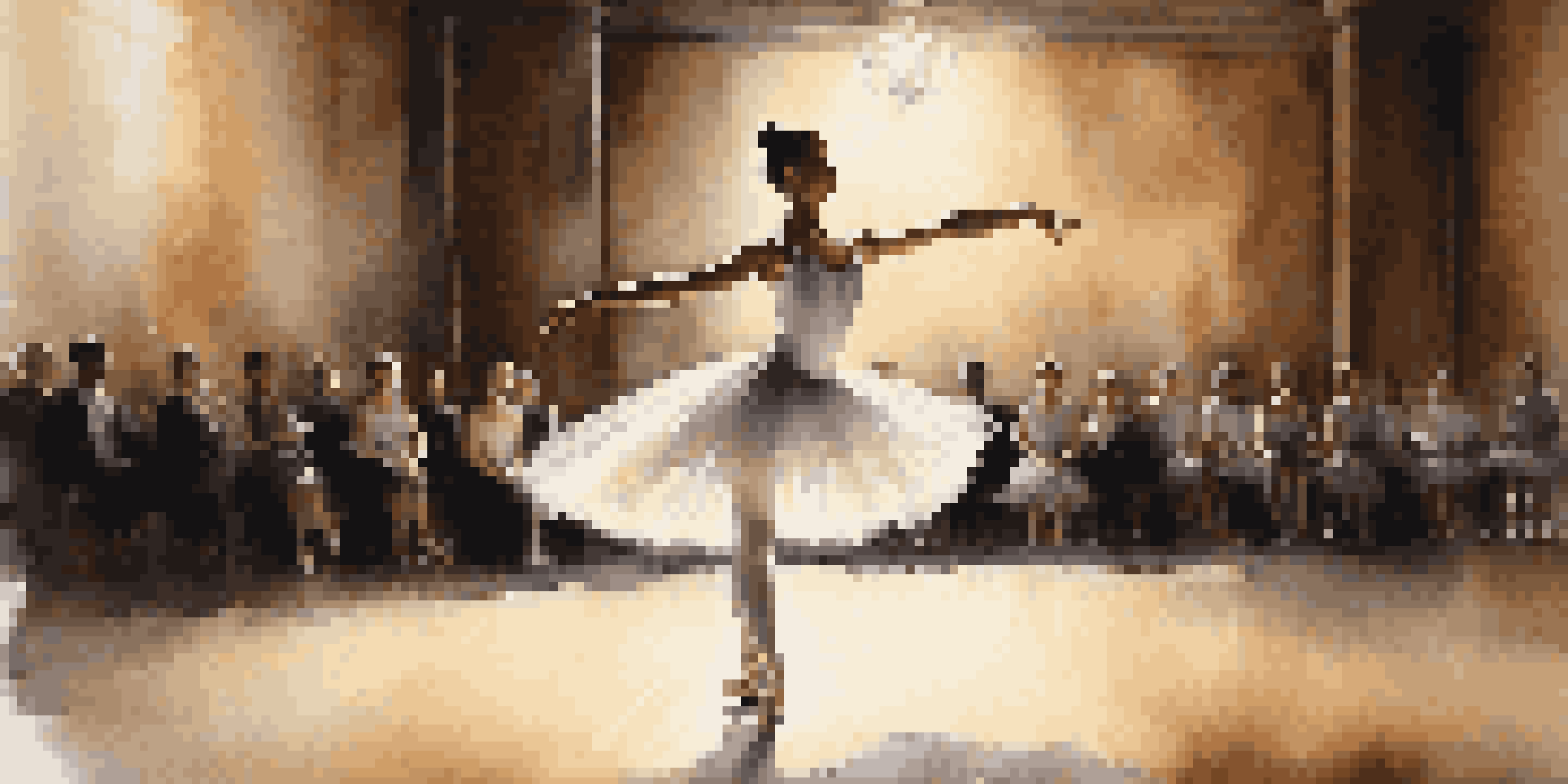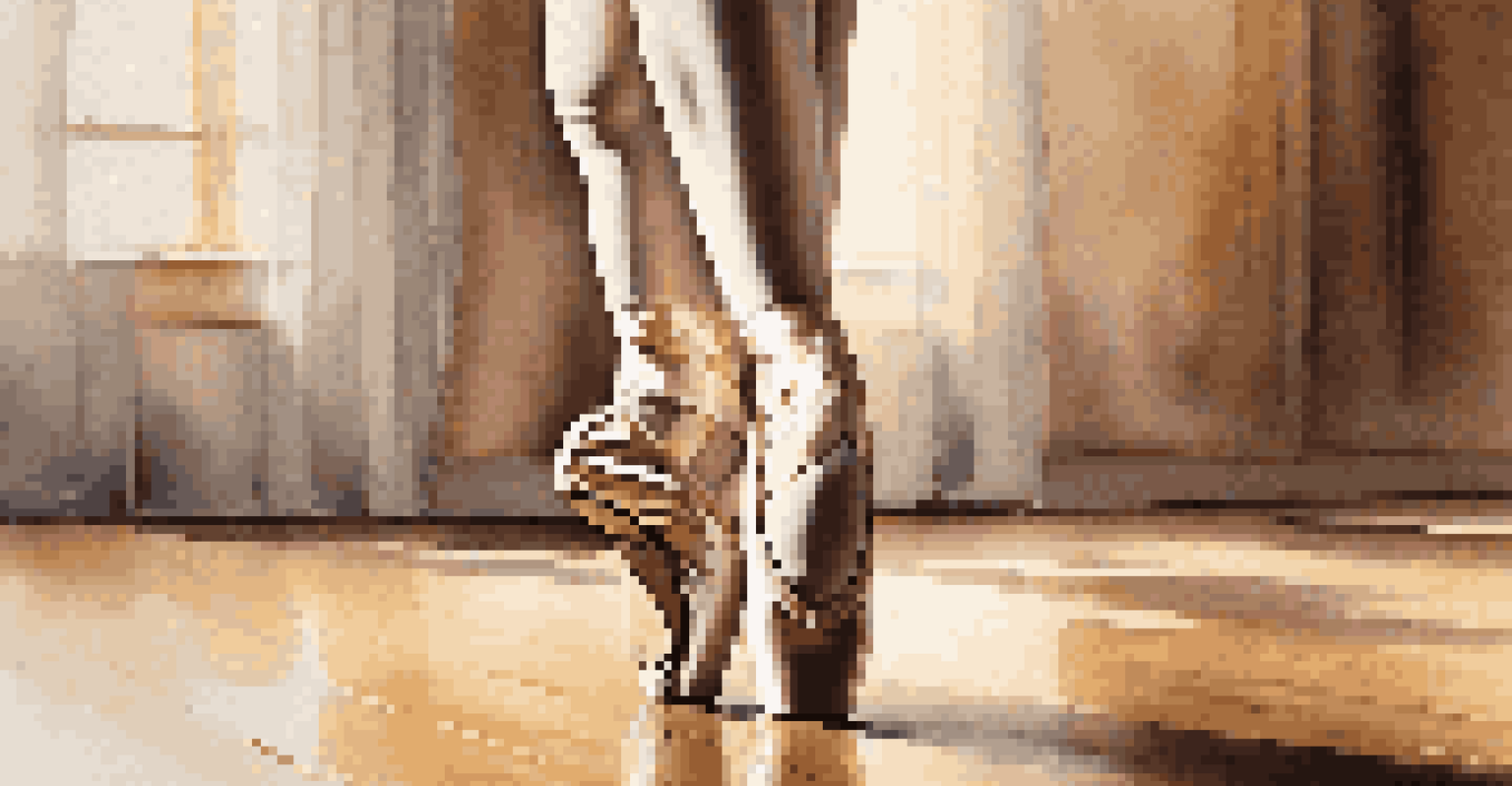Exploring the Connection Between Dance Technique and Emotion

Understanding Dance Technique: The Foundation of Movement
Dance technique encompasses the skills and methods that dancers use to execute movements effectively. This foundation includes posture, alignment, and control, which are essential for any style of dance. Without a solid grasp of technique, dancers may struggle to convey the emotions behind their movements.
Dance is the hidden language of the soul.
For example, consider a ballet dancer executing a pirouette. The precision of their technique not only showcases their skill but also sets the stage for emotional expression. The way they hold their arms, the strength in their core, and the grace in their landing all contribute to how the audience perceives their emotions.
Ultimately, dance technique serves as a canvas on which emotions can be painted. When dancers master these fundamental aspects, they can then focus on infusing their movements with the stories and feelings they wish to share.
The Role of Emotion in Dance Performance
Emotion is the soul of dance, transforming mere movement into a captivating performance. Dancers often draw from personal experiences or the underlying narrative of a piece to evoke genuine feelings. This emotional connection can resonate deeply with the audience, creating a shared experience that transcends words.

For instance, a contemporary dancer may use fluid movements to express sorrow, while sharp, staccato motions might convey anger. The ability to embody these emotions through movement can leave a lasting impression, demonstrating that dance is more than just technique—it's an emotional language.
Technique is Essential for Dance
Mastering dance technique lays the groundwork for effective movement and emotional expression.
In essence, emotion breathes life into dance. It is this emotional depth that invites audiences to connect with the performance on a personal level, often eliciting empathy and reflection.
How Technique Enhances Emotional Expression
While emotion is crucial, the execution of movement can significantly enhance its impact. A well-honed technique allows dancers to control their bodies and convey subtle nuances that evoke stronger feelings. For example, a small shift in posture can dramatically change the emotion being portrayed.
The body says what words cannot.
Consider a dancer performing a solo piece about love. If their technique allows for fluid transitions and seamless shifts in dynamics, the portrayal will feel more genuine and relatable. The audience can sense the authenticity, leading to a deeper emotional response.
Thus, technique and emotion are intertwined; one cannot flourish without the other. When dancers master their technique, they unlock the potential to express complex emotions with clarity and depth.
Creating a Narrative Through Dance Movements
Dance is often described as storytelling without words. Each movement can represent a part of a narrative, and the combination of technique and emotion helps to weave this story together. A skilled dancer knows how to manipulate their movements to guide the audience through the intended emotional journey.
For instance, in a narrative ballet, the choreography might reflect a character's progression from joy to heartbreak. The dancer's technique allows for distinct shifts in movement quality that mirror these emotional changes, making the story more relatable and engaging.
Emotion Drives Dance Performance
The emotional connection in dance transforms movements into a compelling narrative that resonates with audiences.
By embracing this narrative aspect, dancers can elevate their performances, offering audiences an immersive experience. It's a beautiful reminder that dance, at its core, is about communication and connection.
The Influence of Music on Dance Emotion and Technique
Music plays a pivotal role in both dance technique and emotional expression. The rhythm, tempo, and dynamics of a piece can guide a dancer's movements, influencing how they interpret the choreography. A fast-paced song might lead to energetic, sharp movements, while a slow melody could inspire graceful, flowing motions.
Moreover, the emotional tone of the music can enhance the dancer's connection to the piece. For example, a melancholic tune may prompt a dancer to embody feelings of longing and nostalgia, while an upbeat track might encourage joy and celebration. This synergy between music and movement deepens the emotional impact of the performance.
In summary, music is a catalyst that fuels both technical execution and emotional engagement, creating a harmonious relationship that elevates dance to an art form.
Training the Mind and Body for Emotional Expression
Training in dance is not solely about physical strength; it also involves mental preparation. Dancers must learn to connect their emotions with their movements, allowing their bodies to express what they feel. This mental conditioning is as crucial as mastering technical skills.
For instance, many dancers practice mindfulness and visualization techniques to enhance their emotional expression. By visualizing their emotions while dancing, they can more effectively convey these feelings to their audience. This practice fosters a deeper connection between the dancer's mind, body, and emotions.
Music Enhances Dance Expression
The synergy between music and movement deepens emotional engagement, enriching the overall dance experience.
Thus, developing both physical and mental aspects of dance is essential for truly expressive performances. It's a holistic approach that leads to more authentic and impactful storytelling through movement.
The Impact of Dance on Emotional Well-being
Dance is not just a form of artistic expression; it also plays a significant role in emotional well-being. Engaging in dance can serve as a therapeutic outlet, allowing individuals to process emotions and relieve stress. This connection to emotions can lead to greater self-awareness and personal growth.
For example, many dancers find that performing can be cathartic, helping them to channel their feelings into their movements. This release can foster a sense of freedom and empowerment, both on and off the stage. It's a powerful reminder of how movement and emotion are intertwined in our lives.

Ultimately, the relationship between dance and emotional health highlights the importance of nurturing this connection. By exploring and expressing emotions through dance, individuals can experience profound transformations, benefiting their overall well-being.